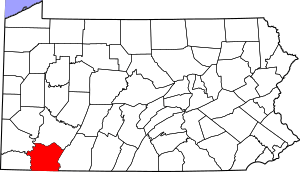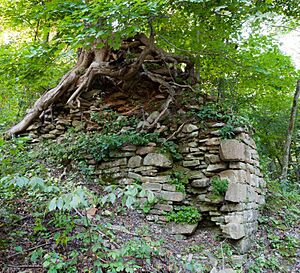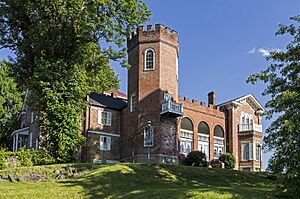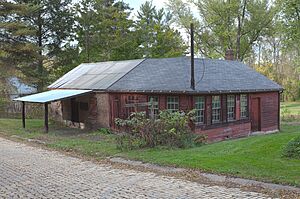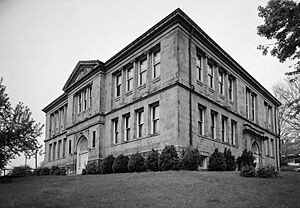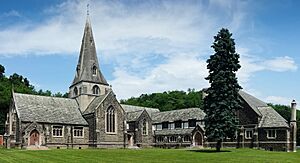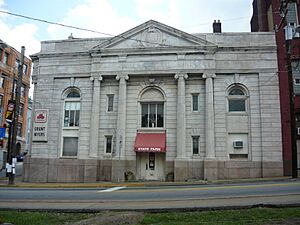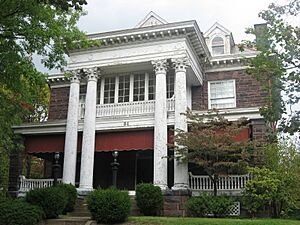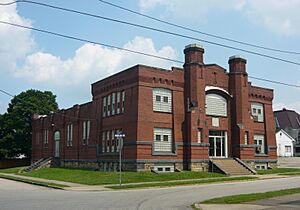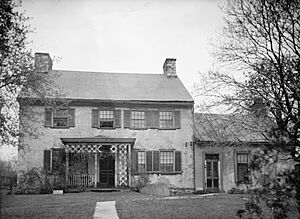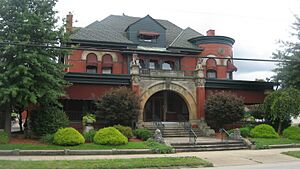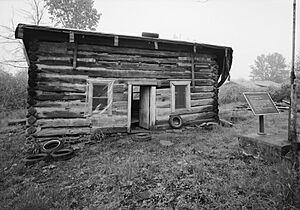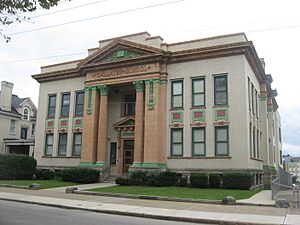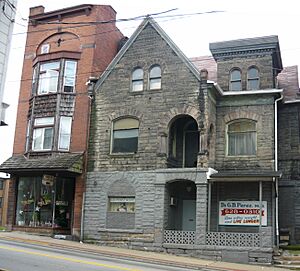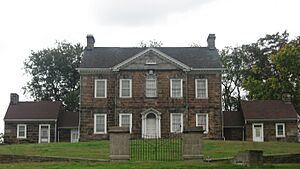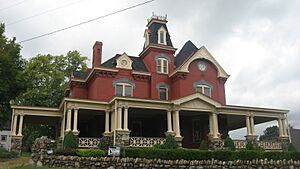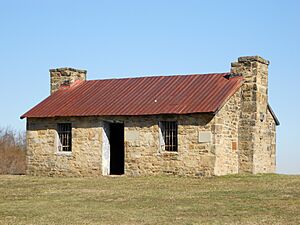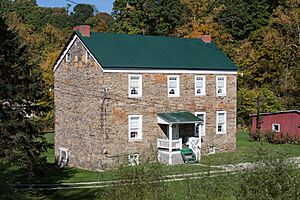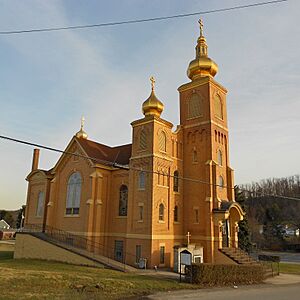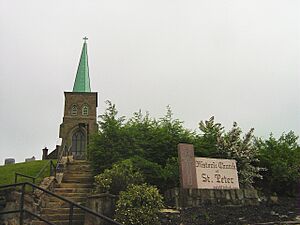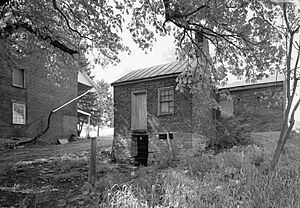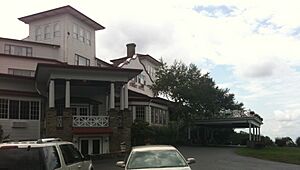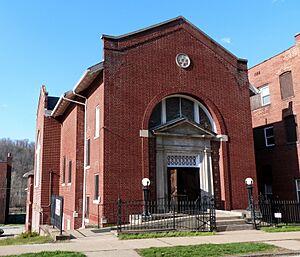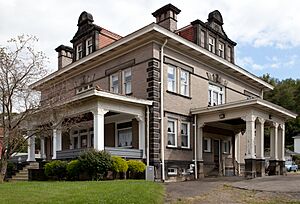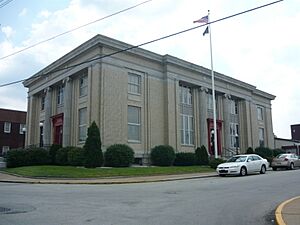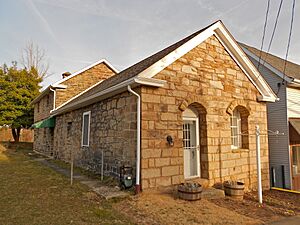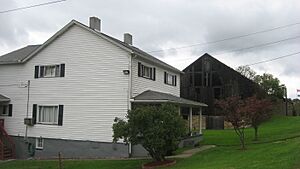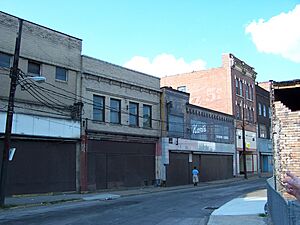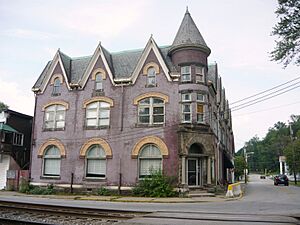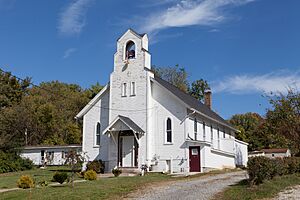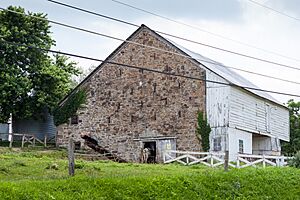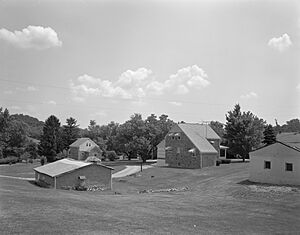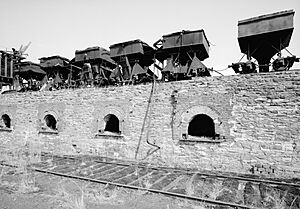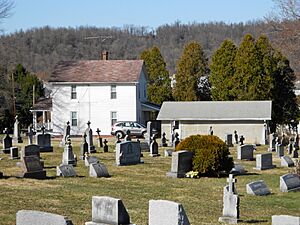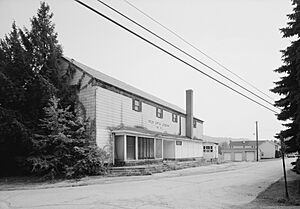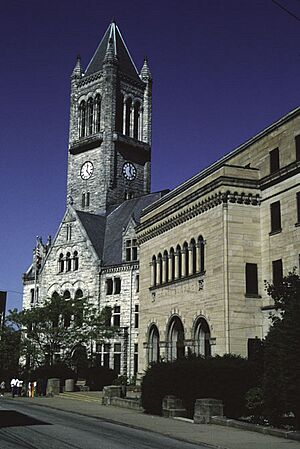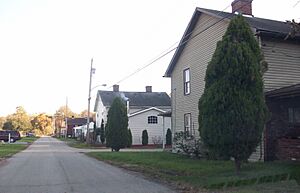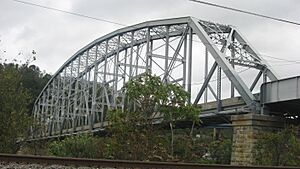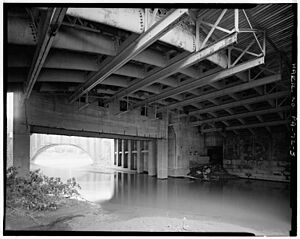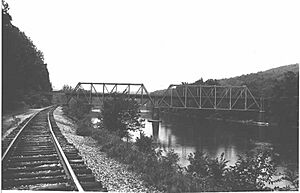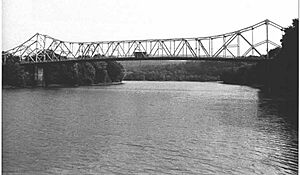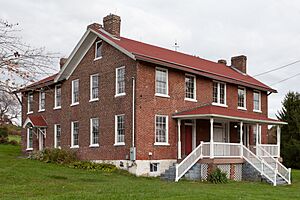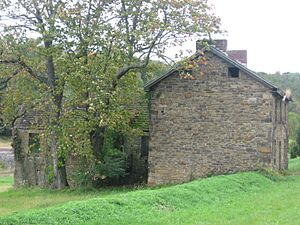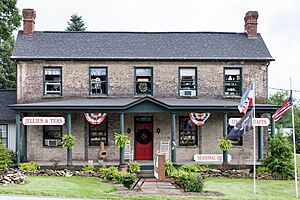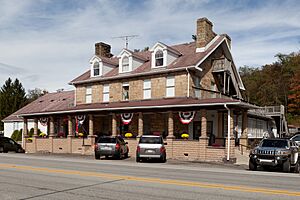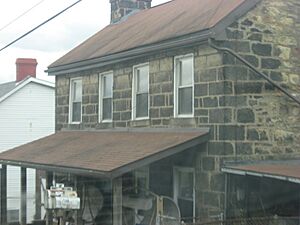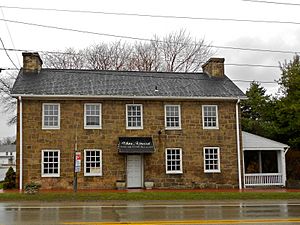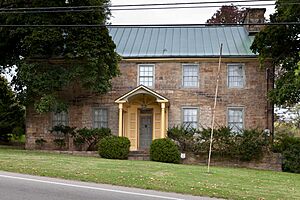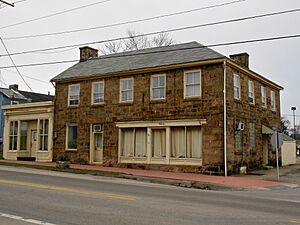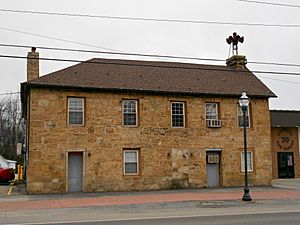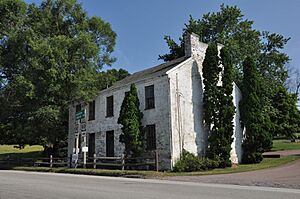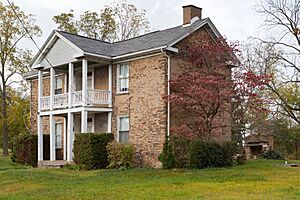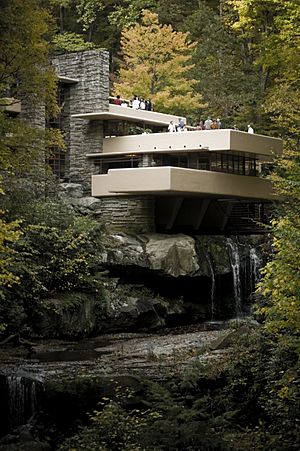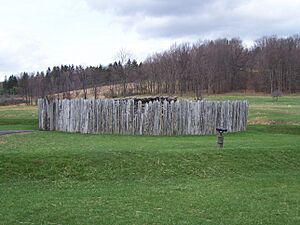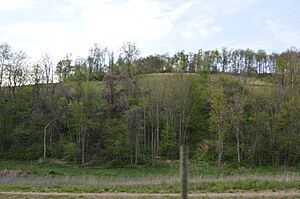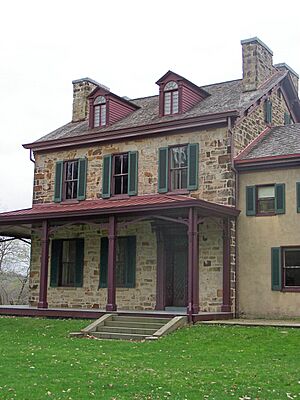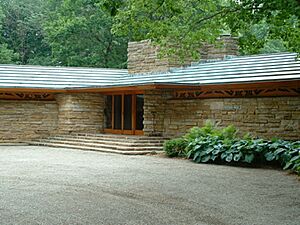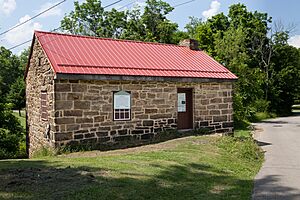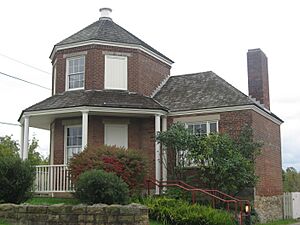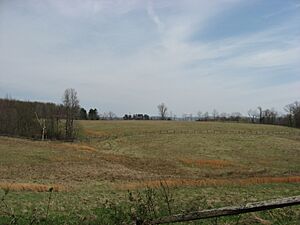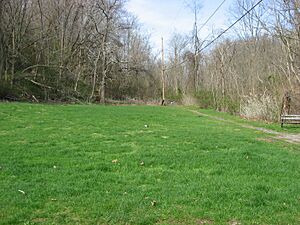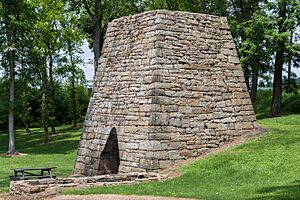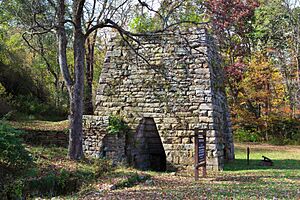National Register of Historic Places listings in Fayette County, Pennsylvania facts for kids
Welcome to Fayette County, Pennsylvania! This page is all about the amazing historic places in our county that are listed on the National Register of Historic Places. Think of this register as a special list of buildings, sites, and districts across the United States that are super important because of their history, architecture, or what they mean to our culture.
Fayette County has 68 places on this list! Some are even more special, like National Historic Landmarks, which are recognized as important to the entire nation. You'll find old houses, bridges, churches, and even places where important events happened. Let's explore some of these cool spots!
Contents
- Historic Gems of Fayette County
- Old Buildings and Homes
- Alliance Furnace: First Ironworks
- Bowman's Castle: A Secret History
- Brown-Moore Blacksmith Shop: Tools of the Past
- Carnegie Free Library: A Gift of Knowledge
- Philip G. Cochran Memorial United Methodist Church: A Medieval Look
- Colonial National Bank Building: Grand Design
- John P. Conn House: Coal Baron's Home
- Connellsville Armory: A Century of Service
- Col. Edward Cook House: A Family Home for Centuries
- John S. Douglas House: Romanesque Style
- Thomas Gaddis Homestead: Oldest in Fayette County
- Gallatin School: A Classical Education
- Dr. J.C. McClenathan House and Office: Unique Mix of Styles
- Isaac Meason House: Rare Stone Style
- Adam Clarke Nutt Mansion: Coal Baron's Grand Home
- Oak Hill Estate: A Monastery's Home
- Providence Quaker Cemetery and Chapel: A Stone Church
- Andrew Rabb House: Whiskey Distiller's Home
- St. Nicholas Byzantine Catholic Church: Unique Style
- St. Peter's Church: Oldest Congregation
- Springer Farm: An Old Brick Farmhouse
- Summit Hotel: A Scenic Retreat
- Temple Ohave Israel: A Place of Worship
- Thomas H. Thompson House: Spanish Revival Mansion
- United States Post Office-Connellsville: Colonial Style
- Youghiogheny Bank of Pennsylvania: First Formal Bank
- Historic Districts: Whole Neighborhoods of History
- Brier Hill: A Coal Mining Community
- Brownsville Commercial Historic District: Business Hub
- Brownsville Northside Historic District: National Road Stop
- Dawson Historic District: Coal Boom Town
- New Geneva Historic District: Pottery Town
- Peter and Jonathan Newmyer Farm: German-Style Barn
- Penn-Craft Historic District: A Community's Spirit
- Shoaf Historic District: Miners' Homes and Coke Ovens
- Smock Historic District: A Company Town
- Star Junction Historic District: Coal Company Life
- Uniontown Downtown Historic District: Wealth from Coal
- Whitsett Historic District: Wood Frame Homes
- Bridges: Connecting the Past and Present
- Taverns and Inns: Stops on the National Road
- Abel Colley Tavern: A Stop for Travelers
- Peter Colley Tavern and Barn: Oldest Tavern
- Downer Tavern: Another National Road Stop
- Fayette-Springs Hotel: Still Operating
- Josiah Frost House: Federal Style Stop
- Hopwood-Miller Tavern: An Early National Road Tavern
- Johnson-Hatfield Tavern: An 1817 Inn
- Monroe Tavern: Early Republic Style
- Morris-Hair Tavern: An 1818 Inn
- Rush House: A Tavern from 1837
- Wallace-Baily Tavern: Greek Portico
- Important Historical Sites
- Fallingwater: Frank Lloyd Wright's Masterpiece
- Fort Necessity National Battlefield: George Washington's Only Defeat
- Francis Farm Petroglyphs: Ancient Rock Art
- Friendship Hill National Historic Site: Albert Gallatin's Home
- Kentuck Knob: Another Wright Home
- Searight's Fulling Mill: Early Manufacturing
- Searights Tollhouse, National Road: Collecting Tolls
- Archaeological Sites: Peeking into the Past
- Industrial History: Furnaces and Mills
- Old Buildings and Homes
Historic Gems of Fayette County
Old Buildings and Homes
These buildings tell stories of how people lived long ago, from early settlers to wealthy coal mine owners.
Alliance Furnace: First Ironworks
The Alliance Furnace is a really old iron furnace from 1789. It was the very first one built west of the Appalachian Mountains! Imagine how important that was for making tools and other metal items back then.
Bowman's Castle: A Secret History
Also known as Nemacolin Castle, Bowman's Castle started as a trading post in the 1750s. It later became a grand mansion in the mid-1800s. This castle has a fascinating history, including connections to the Underground Railroad, a secret network that helped enslaved people find freedom.
Brown-Moore Blacksmith Shop: Tools of the Past
The Brown-Moore Blacksmith Shop was built in the early 1800s. It was a place where blacksmiths made and repaired metal tools, and it also served as a general store for the community. It gives us a peek into daily life from a long time ago.
Carnegie Free Library: A Gift of Knowledge
The Carnegie Free Library in Connellsville is a beautiful building from 1903. It's built in the Italianate style, which was popular at the time. This library was part of a system of libraries funded by Andrew Carnegie, a famous businessman who believed in giving everyone access to books and learning.
Philip G. Cochran Memorial United Methodist Church: A Medieval Look
The Philip G. Cochran Memorial United Methodist Church in Dawson was built in 1927. It's designed in the Gothic Revival style, made to look like a 14th-century English church. It's a stunning example of how old European styles influenced American architecture.
Colonial National Bank Building: Grand Design
The Colonial National Bank Building in Connellsville, built in 1906, shows off the Greek Revival style. It's a grand building that still serves as an office building today.
John P. Conn House: Coal Baron's Home
The John P. Conn House in Uniontown is a well-preserved home from 1906. It's a great example of a Colonial Revival home from the time of the "coal barons," who were wealthy people who made their money from the coal mining industry.
Connellsville Armory: A Century of Service
The Connellsville Armory is a large Gothic Revival building from 1907. For almost a hundred years, it was used as a training station for the Pennsylvania National Guard.
Col. Edward Cook House: A Family Home for Centuries
The Col. Edward Cook House was built in 1776, the same year the United States declared independence! This traditional American home was lived in by the same family for 200 years, which is a very long time!
John S. Douglas House: Romanesque Style
The John S. Douglas House in Uniontown, built in 1901, is now a funeral home. It shows off the Richardsonian Romanesque style, which features strong, heavy stone and rounded arches.
Thomas Gaddis Homestead: Oldest in Fayette County
The Thomas Gaddis Homestead is the oldest building in Fayette County! It's also the second oldest log cabin in all of Western Pennsylvania. Imagine the stories this cabin could tell about early life here.
Gallatin School: A Classical Education
The Gallatin School in Uniontown was built in 1908 in the Classical Revival style. It used to be a school building and is a good example of the grand architecture used for public buildings in that era.
Dr. J.C. McClenathan House and Office: Unique Mix of Styles
The Dr. J.C. McClenathan House and Office in Connellsville shows a cool mix of Romanesque and Queen Anne architectural styles. It was a medical office, and its design makes it stand out.
Isaac Meason House: Rare Stone Style
The Isaac Meason House, also known as Mount Braddock, is an amazing mansion from 1802. It's one of only two buildings in the entire country that shows off the Palladian stone-cut style. It's a very unique and important piece of architecture.
Adam Clarke Nutt Mansion: Coal Baron's Grand Home
The Adam Clarke Nutt Mansion in Uniontown is another grand home from the "coal baron" era. Built in 1990, it combines the Queen Anne and Second Empire building styles, showing the wealth and taste of the time.
Oak Hill Estate: A Monastery's Home
The Oak Hill Estate is a Classical Revival mansion from the "coal baron" era. Today, it's part of the Mount Saint Macrina monastery, a peaceful and historic place.
Providence Quaker Cemetery and Chapel: A Stone Church
The Providence Quaker Cemetery and Chapel in Perry Township features a stone church built in 1895. The nearby cemetery has many gravestones from the early 1800s, telling stories of the community's past.
Andrew Rabb House: Whiskey Distiller's Home
The Andrew Rabb House is a Georgian-style home built in 1773. It was constructed by a famous whiskey distiller, showing the history of early industries in the area.
St. Nicholas Byzantine Catholic Church: Unique Style
The St. Nicholas Byzantine Catholic Church in Perryopolis was finished in 1918. It's built in the Byzantine Revival style, which gives it a very distinct and beautiful look, different from many other churches.
St. Peter's Church: Oldest Congregation
St. Peter's Church in Brownsville has the oldest continuously operating church congregation of any faith in Western Pennsylvania! The current church building was constructed in 1843. It's a grand cathedral, designed to be a very important church in the region.
Springer Farm: An Old Brick Farmhouse
The Springer Farm features a brick farmhouse that dates back to 1817. It's a great example of a traditional farm home from that period.
Summit Hotel: A Scenic Retreat
The Summit Hotel opened in 1907 and is built in the Mission Revival style. It's still operating today on a beautiful, scenic hilltop, offering great views.
Temple Ohave Israel: A Place of Worship
Temple Ohave Israel in Brownsville is a significant place of worship. It was added to the National Register in 2016, recognizing its importance to the community.
Thomas H. Thompson House: Spanish Revival Mansion
The Thomas H. Thompson House in Brownsville was built in 1906. This Spanish Revival mansion also dates back to the "coal baron" era, showing the variety of architectural styles chosen by wealthy residents.
United States Post Office-Connellsville: Colonial Style
The US Post Office-Connellsville, built in 1913, is a handsome example of the Colonial Revival style. Many government buildings from that time were designed to look grand and official.
Youghiogheny Bank of Pennsylvania: First Formal Bank
The Youghiogheny Bank of Pennsylvania in Perryopolis is a simple stone building from 1817. It's important because it once housed the very first formal bank in Western Pennsylvania!
Historic Districts: Whole Neighborhoods of History
Historic districts are areas with many buildings that share a common history or architectural style.
Brier Hill: A Coal Mining Community
Brier Hill is a well-preserved example of a coal mining community from the late 1800s and early 1900s. It shows what life was like for miners and their families.
Brownsville Commercial Historic District: Business Hub
The Brownsville Commercial Historic District includes 55 business buildings built between the 1870s and 1930s. Even though many are empty now, they show how important Brownsville was as a business center in the industrial Monongahela Valley.
Brownsville Northside Historic District: National Road Stop
The Brownsville Northside Historic District has 230 buildings from the 1800s and early 1900s. These buildings show the town's history as a key stop on the National Road, an important early American highway. You can see Federal, Greek Revival, and Colonial Revival styles.
Dawson Historic District: Coal Boom Town
The Dawson Historic District features 107 buildings, many built during the coal boom of the early 1900s. It gives us a picture of a town that grew rapidly because of coal mining.
New Geneva Historic District: Pottery Town
The New Geneva Historic District has 29 buildings in the Federal and Queen Anne styles. It tells the story of a small industrial town founded by Albert Gallatin that was known for making pottery until the early 1900s.
Peter and Jonathan Newmyer Farm: German-Style Barn
The Peter and Jonathan Newmyer Farm includes 8 buildings from the 1700s and 1800s. It even has a traditional German-style bank barn, which is a barn built into a hillside.
Penn-Craft Historic District: A Community's Spirit
The Penn-Craft Historic District has 108 buildings from when the village was founded during the Great Depression. It was created as a self-sufficient community for miners who were struggling with poverty and unemployment. It's a powerful story of community resilience.
Shoaf Historic District: Miners' Homes and Coke Ovens
The Shoaf Historic District has 39 buildings, including old coke ovens and traditional duplex homes for miners. These homes would have been owned by the mine operator, showing how company towns worked.
Smock Historic District: A Company Town
The Smock Historic District contains 177 buildings in this former company town. It includes duplexes for mine employees and separate homes for supervisors, giving a clear picture of life in a coal mining town.
Star Junction Historic District: Coal Company Life
The Star Junction Historic District preserves 163 buildings, mostly duplexes for miners and detached homes for supervisors. It helps us understand what life was like in a traditional coal company town.
Uniontown Downtown Historic District: Wealth from Coal
The Uniontown Downtown Historic District features 113 buildings from the late 1800s and early 1900s. These detailed apartment and office buildings, along with the grand Romanesque courthouse, show the wealth that came from coal mining and coke production in the area.
Whitsett Historic District: Wood Frame Homes
The Whitsett Historic District includes 48 buildings from when it was founded as a coal mining company town. It's known for its wood frame duplex homes, which were typical for miners.
Bridges: Connecting the Past and Present
These bridges are not just ways to cross rivers; they are important examples of engineering and history.
Brownsville Bridge: A 1914 Truss Bridge
The Brownsville Bridge was built in 1914. It's a Pennsylvania truss style bridge that crosses the Monongahela River. Part of this bridge also extends into Washington County, Pennsylvania.
Dunlap's Creek Bridge: First Cast Iron Bridge
The Dunlap's Creek Bridge is an amazing structure from 1839. It's still in use today and holds the special title of being the very first cast iron bridge ever built in the United States!
Layton Bridge: From Railroad to Road
The Layton Bridge was built in 1899 as a Pratt truss railroad bridge. Since 1933, it has been used for cars. Fun fact: this bridge was featured in the movie The Silence of the Lambs!
Marion Bridge: A Cantilevered Truss Bridge
The Marion Bridge, also known as the Albert Gallatin Memorial Bridge, was a cantilevered truss bridge built in 1930. It crossed the Monongahela River and connected Fayette County to Greene County, Pennsylvania. Sadly, it was taken down in 2009.
Taverns and Inns: Stops on the National Road
Many of these historic places were taverns or inns along the National Road, one of the first major improved highways in the United States. They offered food, drink, and lodging to travelers.
Abel Colley Tavern: A Stop for Travelers
The Abel Colley Tavern is an 1835 tavern from the National Road era. It was a place where travelers could rest and get a meal on their journey.
Peter Colley Tavern and Barn: Oldest Tavern
The Peter Colley Tavern dates back to 1796, making it one of the oldest taverns from the National Road era. It also has an early 1800s farmhouse and other buildings nearby.
Downer Tavern: Another National Road Stop
The Downer Tavern was built in 1826 and was another important stop along the National Road for travelers.
Fayette-Springs Hotel: Still Operating
The Fayette-Springs Hotel is an inn from 1822, also located on the National Road. What's cool is that it still operates as a restaurant today!
Josiah Frost House: Federal Style Stop
The Josiah Frost House is an 1822 Federal style building that served as a stop on the National Road.
Hopwood-Miller Tavern: An Early National Road Tavern
The Hopwood-Miller Tavern is a National Road tavern that dates back to 1816, making it one of the earlier ones.
Johnson-Hatfield Tavern: An 1817 Inn
The Johnson-Hatfield Tavern was built in 1817 as an inn on the National Road, providing a place for weary travelers to stay.
Monroe Tavern: Early Republic Style
The Monroe Tavern from 1825 shows the "Early Republic" style of construction. It was another tavern along the busy National Road.
Morris-Hair Tavern: An 1818 Inn
The Morris-Hair Tavern was a former inn on the National Road, built in 1818.
Rush House: A Tavern from 1837
The Rush House was a tavern from the National Road era, completed in 1837.
Wallace-Baily Tavern: Greek Portico
The Wallace-Baily Tavern, an 1840 National Road era tavern, has an impressive Greek portico, which is a porch with columns.
Important Historical Sites
These places mark significant events or discoveries that shaped our history.
Fallingwater: Frank Lloyd Wright's Masterpiece
Fallingwater is a world-famous house designed by the legendary architect Frank Lloyd Wright. It was built in 1937 right over a waterfall! The Smithsonian has even called it one of the "Top 28 Places to Visit Before You Die."
Fort Necessity National Battlefield: George Washington's Only Defeat
Fort Necessity National Battlefield is a very important site from the French and Indian War in 1754. It's where 22-year-old George Washington suffered his only defeat as a commanding officer. The grave of British General Edward Braddock, who died in a nearby battle in 1755, is also here.
Francis Farm Petroglyphs: Ancient Rock Art
The Francis Farm Petroglyphs Site contains a well-preserved collection of petroglyphs, which are ancient rock carvings. These carvings were made by the Woodland period people, giving us a glimpse into their art and culture.
Friendship Hill National Historic Site: Albert Gallatin's Home
Friendship Hill National Historic Site is the estate and 1789 home of Albert Gallatin, an important early American statesman. He was a diplomat and served as Secretary of the Treasury.
Kentuck Knob: Another Wright Home
Kentuck Knob, also known as the Isaac Newton Hagan House, is another amazing home designed by Frank Lloyd Wright, built in 1956. It's special because it's built right into a rocky hillside.
Searight's Fulling Mill: Early Manufacturing
The Searight's Fulling Mill from 1810 shows what small, local manufacturing was like in the early industrial era. A fulling mill was used to clean and thicken wool cloth.
Searights Tollhouse, National Road: Collecting Tolls
The Searights Tollhouse was built in 1834 to collect tolls along the National Road. It was one of six such buildings in Pennsylvania and operated until 1905. It's a great example of how early roads were funded.
Archaeological Sites: Peeking into the Past
These sites are where archaeologists find clues about ancient cultures and how people lived thousands of years ago.
Deffenbaugh Site: Ancient Village
The Deffenbaugh Site is an archaeological site where an ancient village of the Monongahela culture was discovered. This helps us learn about the native people who lived here long before European settlers arrived.
Locus 7 Site: Another Monongahela Village
The Locus 7 Site is another important archaeological site. It contains the remains of an ancient Monongahela village, giving more insights into this early culture.
Industrial History: Furnaces and Mills
These sites show the early industries that were important to Fayette County's development.
Mount Vernon Furnace: Iron Production
The Mount Vernon Furnace was a traditional iron blast furnace that operated from 1795 to 1825. It was key to producing iron for tools and other goods in the early days of the county.
Wharton Furnace: Another Blast Furnace
The Wharton Furnace was another traditional blast furnace used for iron production from 1839 to 1850. These furnaces were vital for the region's economy.


